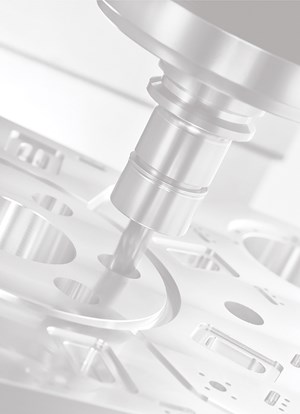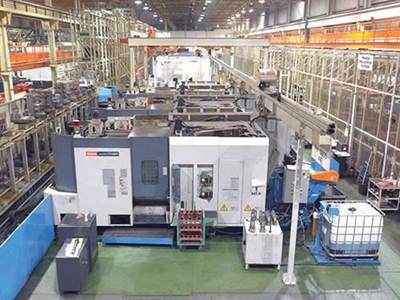Big Screens—Big Results
This machine tool builder is getting the most from its machine monitoring system. Making data about machine utilization very visible is helping operators make better decisions about shopfloor activities.
Share



At its Florence, Kentucky, manufacturing plant, machine tool builder Mazak has been aggressively implementing its iSMART Factory concept, a production strategy based on the concepts and goals of data-driven manufacturing. The foundation for this project is an MTConnect-enabled machine monitoring system.
I spoke to Ben Schawe, VP of manufacturing; Mark Wiesman, fabrication manager; and Rocky Rowland, FMF assistant manager, about some of the main lessons learned during this implementation, which has been underway for about three years. This is a summary of their remarks:
1. Building an appropriate data infrastructure is the first step. Mr. Schawe explained that the core of this infrastructure is a network of fiber optic cables with line drops at selected locations. This network facilitated the installation of 60-inch display screens throughout the manufacturing areas to show the data collected and analyzed by the machine monitoring system.
2. Use a pilot project to ease the learning curve and get everyone on board. The first display screens were installed in late 2013 to connect 15 machining centers to the system, which uses the MTConnect interoperability standard to interface with the disparate CNCs on these machines. Supervisors and operators were involved in evaluating the machine monitoring software, encouraged to provide input and given a clear understanding of the direction that this data-driven manufacturing initiative was taking.
With the successful completion of this pilot project, the monitoring system has now been expanded to include six display screens and 55 machines that are actively being monitored.
3. At first, visual awareness creates quick (and significant) results. Mr. Rowland reported that just by showing operators a report of machine utilization, their thinking and practices became more focused on improvements that boosted uptime. “Simply by seeing what’s going on, they started making better decisions about the way they prepared cutting tools, managed the use of program stops and attended to routine maintenance items,” he said. The result was a 6 to 15 percent increase in utilization per machine.
4. Be sure that data translates into actionable information that helps the operators. One example mentioned by Mr. Wiesman involved his fabrication line. A review of utilization of the laser cutting cells indicated what appeared to be an excessive number of interruptions to running them in the automated mode. Checking with the operators revealed that “optional” (emergency or expedited) parts were being processed on these cells because cutting was much faster than on the hand-loaded laser machines. In fact, this approach was yielding no gain in overall output. Restricting these optional parts to off-line processing restored 12 to 13 percent productivity to the automated cells.
Going forward, Mazak plans to expand its drive to base decisions on data. One new phase requires direct operator input. Mr. Schawe said that the goal is to enable operators to enter data quickly and easily. “Touchpads will be installed where operators can simply walk up, tap the data field they want to enter, and then pick a few choices. To enter, let’s say, reasons for a pause in machining, the options will be short and straightforward: waiting on tooling, adjusting fixtures, replenishing coolant, indexing inserts and so on,” he said.
The plant also plans to install sensors so that the operating parameters of additional manufacturing systems can be monitored. The perfect example of this will be the newly completed powder coating line for machine enclosure components. Mr. Weisman explained that the new sensors will detect line speed, temperature and pH of wash baths, drying oven temperature, powder levels, and other measurements. All readings will be displayed on one screen for at-a-glance viewing. “Any trend that needs adjustment will be visible, giving operators time to respond well before a condition becomes critical,” Mr. Wiesman said.
Related Content
2 Secondary Coordinate Systems You Should Know
Coordinate systems tell a CNC machine where to position the cutting tool during the program’s execution for any purpose that requires the cutting tool to move.
Read MoreOrthopedic Event Discusses Manufacturing Strategies
At the seminar, representatives from multiple companies discussed strategies for making orthopedic devices accurately and efficiently.
Read MoreContinuous Improvement and New Functionality Are the Name of the Game
Mastercam 2025 incorporates big advancements and small — all based on customer feedback and the company’s commitment to keeping its signature product best in class.
Read MoreAerospace Shop Thrives with Five-Axis, AI and a New ERP
Within three years, MSP Manufacturing has grown from only having three-axis mills to being five-axis capable with cobots, AI-powered programming and an overhauled ERP. What kind of benefits do these capabilities bring? Find out in our coverage of MSP Manufacturing.
Read MoreRead Next
Data-Driven Manufacturing Moves Ahead at Mazak
“We thought we knew what our utilization was, but now we know for sure.
Read MoreOEM Tour Video: Lean Manufacturing for Measurement and Metrology
How can a facility that requires manual work for some long-standing parts be made more efficient? Join us as we look inside The L. S. Starrett Company’s headquarters in Athol, Massachusetts, and see how this long-established OEM is updating its processes.
Read More















.png;maxWidth=300;quality=90)











